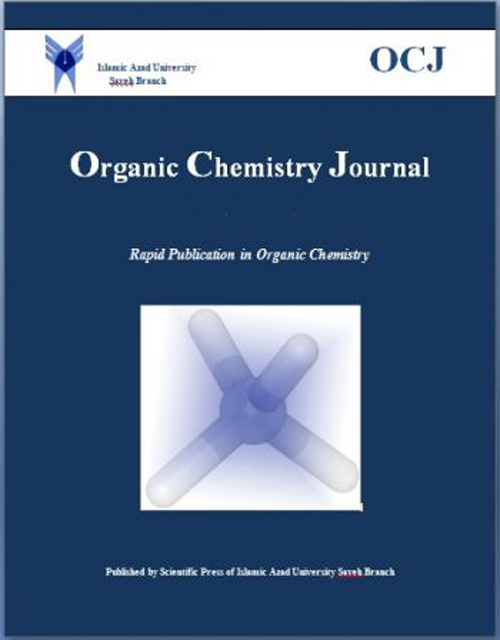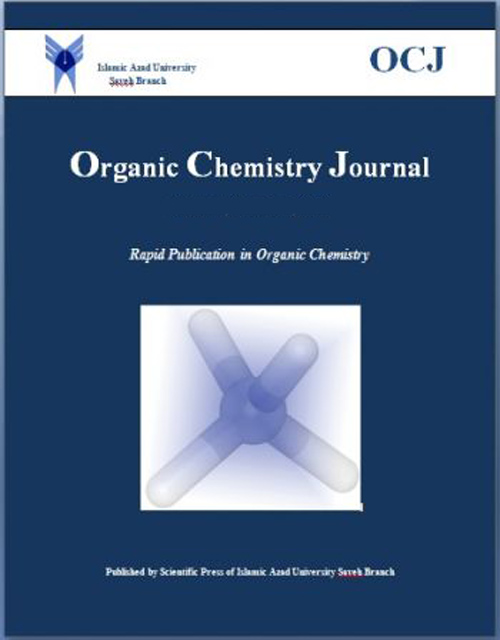فهرست مطالب

Organic Chemistry Journal
Volume:1 Issue: 1, 2010
- تاریخ انتشار: 1394/11/26
- تعداد عناوین: 8
-
Page 1Various cyanohydrin acetates were obtained in good yields by solvent-free treatment of aldehydes with acetic anhydride and TMSCN in the presence of catalytic amounts of magnesium bromide diethyl etherate.Keywords: Cyanohydrin acetates, MgBr2.OEt2, aldehydes, TMSCN
-
Page 6CBS-QB3 and density functional theory studies of the [3,3]-sigmatropic rearrangements of several allylic azides indicate that this reaction is a concerted process that proceeds via a half-chair transition state. The activation barriers for rearrangements of hydroxyl azides are lower than those of the corresponding aliphatic azides. The epoxidations and phenyl azide cycloadditions of allylic azides were also studied.Keywords: Azide, [3, 3]-sigmatropic rearrangement, cycloaddition, DFT
-
Highly ive Aldol Condensation Using Amine-functionalized SiO2-Al2O3 Mixed-oxide Under Solvent-free ConditionPage 7Catalytic activities of SiO2-Al2O3 mixed-oxide with various SiO2/Al2O3 molar ratio functionalized with trimethoxysilylpropylamine ((CH3O)3Si(CH2)3NH2) were studied for Aldol condensation of benzaldehyde and 1-heptanal in order to produce jasminaldehyde at different reaction parameters. The number of Aldol condensation reactions was carried out using a variety of aromatic aldehydes at optimum conditions.Keywords: Aldol condensation, jasminaldehyde, 1-heptanal, amine-functionalized, solvent-free
-
Page 15Differential Scanning Calorimetry (DSC), which measures the heat flow of the sample as a function of temperature, has extensively been used to study the cure kinetics of various thermosetting polymers. For thermal analysis with DSC instrument, standard methods like ASTM E 698 & E 2041 are used in this research. The curing kinetics of FBE was studied by non-isothermal differential scanning calorimetry technique at different heating rates. A series of physical and chemical experiments have been conducted on variety of samples. These include evaluation of density, size distribution, moisture content and gel time. Accordingly the obtained results were accompanied by instrumental analysis including IR spectra studies on the raw samples. base on the findings, Arrhenius constants are obtained for the final cured products. The results show that to achieve a preferable curing reaction the profile of curing is in fact a function of time and temperature.Keywords: Differential Scanning Calorimetery(DSC), Fusion Bonded Epoxy(FBE), curing kinetics, Arrhenius equation, powder coating
-
Page 20Oxidation of benzoin with some mild oxidants was studied in different reaction media. The best result was obtained utilizing Bi5O(OH)9(NO3)4 in boiling acetic acid under air. More investigations revealed a catalytic role for Bi5O(OH)9(NO3)4 in aerobic oxidation of benzoin.Keywords: benzoin, benzil, bismuth, catalyst, oxidation
-
Page 26The aim of the present research is to predict decomposition reaction product of 5,6-difluoro-5,6-dihydrocyclohexa1,3-diene(a) from three possible products, using DFT-B3LYP method. The calculation results showed that 5,6hydrofluoration elimination reaction is most possible, because the required energy (Ea=35.31kcalmol-1) for this reaction is lower than another possibilities (Ea for elimination of 5,6-difluorine=86.03kcalmol-1, Ea for elimination of 5,6-dihydro=68.26 kcalmol-1). We performed a DFT calculation on dehydrofluorination this compound (scheme 1). Also, the Nucleus Independent Chemical Shift (NICS) values in the center of the ring, NICS(0), NICS(0.5), NICS(1) are computed. The NICS(0.5) value of product is the most negative value and indicating its highest aromaticity.Keywords: Elimination, DFT, Ea, NICS
-
Page 30Phenolic compounds are secondary metabolites that are derivatives of the pentose phosphate, shikimate, and phenylpropanoid pathways in plants. The beneficial effects derived from phenolic compounds have been attributed to their antioxidant activity. Pomegranate juice is nutritionally an important beverage since it is consumed frequently for its phenolic compounds.Keywords: phenolic compound, DPPH, antioxidants, PJs, Folin-Ciocalteou
-
Page 49Dry matter accumulation and indole-3-acetic acid (IAA) level of grains in various positions within the wheat (Triticum aestivum L. Var. PBW-343) spike and spikelet were investigated during the grain filling period. Mother shoots were partitioning into proximal, middle and distal regions and further into bold and small grains. Ten labeled spikes were sampled every 4 days from 3 days after anthesis (DAA) to 23 DAA, and every 7 days from 23 DAA to maturity. Results have shown that the IAA level increased rapidly from about 7 until 19 days after anthesis and then decreased depends upon the position of grains in spike and spikelet. The differences in IAA levels, both among spikelets in different regions of the spike and also among grains within a spikelet, were positively correlated with the differences in dry matter accumulation. The close spatial and developmental correlation between IAA concentration and dry matter accumulation indicates a causal relationship between endosperm cell division and/or enlargement and IAA levels. The results suggest that IAA in the grains during the early phase of grain development play an important role in regulating grain filling pattern and consequently influence grain filling percentage.Keywords: IAA, spike, spikelet, dry matter, wheat


